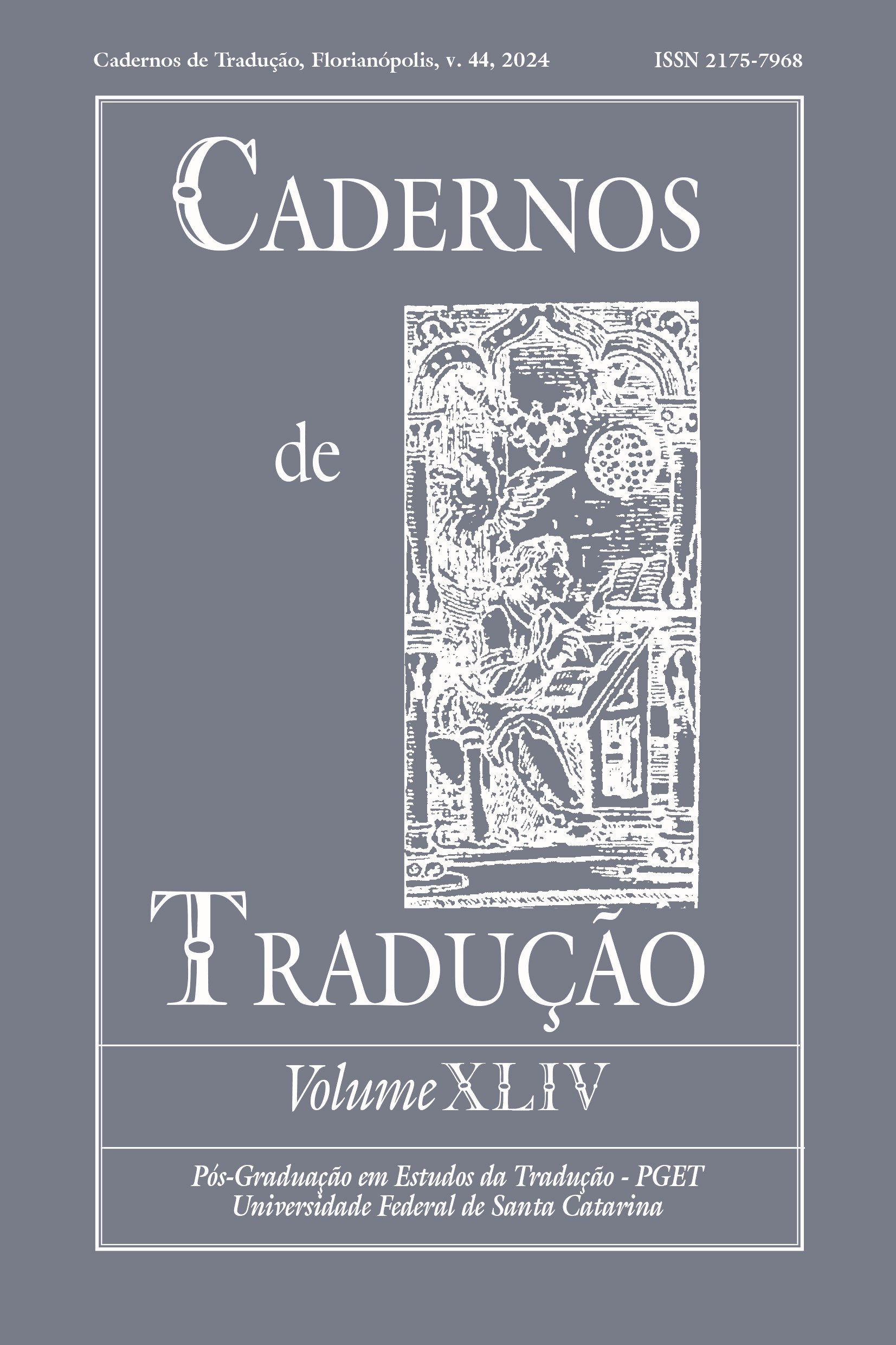Dialogism and intertextuality to translate The comedy of errors
DOI:
https://doi.org/10.5007/2175-7968.2024.e97737Palavras-chave:
Dialogism, Intertextuality, Shakespeare’s translation, The Comedy of ErrorsResumo
The dialogical perspective which approaches literary texts within a web of relationships with other texts and discourses, past and contemporary, may be productive for the analysis, understanding, and translation of Shakespeare’s works. The intertextual connections that every literary text establishes with other discourses determine not only its meaning but also its texture. The purpose of the present essay is to emphasize the importance to identify the dialogical relations of Shakespeare’s plays for a deeper understanding of texts in their contexts, and for avoiding falling into reductionist interpretations or misconceptions. Also, to point out the relevance of taking intertextual phenomena into account in the act of translation, as it facilitates the translator’s mediating task of establishing a dialogue between the languages and cultures involved and making more informed and conscious choices. To showcase the effectiveness of identifying these meaningful relations, the intertextual relations of The Comedy of Errors with other texts and sources, the literary traditions prevailing at the time, and the Elizabethan cultural discourses are analyzed in light of Robert S. Miola’s proposal (2004).
Referências
Amorim, Marcel. (2023). Devouring Hamlet: Cultural Anthropophagy as an Adaptation Methodology. Cadernos de Tradução, 43(1), 1–26. https://doi.org/10.5007/2175-7968.2023.e92576
Apolloni, Jessica. (2022). ‘A Night of Errors’: Chaos, Comedy, and Comparative Law at the Inns of Court. Law, Culture and the Humanities, 0(0), 1–16. https://doi.org/10.1177/17438721221080785
Bakhtin, Mikhail M. (1981). The Dialogic Imagination: Four Essays. (Cary Emerson & Michael Holquist, Trans.). University of Texas Press.
Baldwin, T. W. (1997). Brave New World. In Robert S. Miola (Ed.), The Comedy of Errors: Critical Essays (pp. 93–112). Garland Publishing.
Barthes, Roland. (1981). Theory of the Text. In Robert Young (Ed.), Untying the Text: A Post-Structuralist Reader (pp. 31–47). Routledge.
Belsey, Catherine. (2002). Disrupting Sexual Difference. In John Drakakis (Ed.), Alternative Shakespeares (pp. 170–195). Routledge.
Brandini, Laura Taddei. (2018). Barthes comparatista. In Claudia Amigo Pino, Laura Taddei Brandini, Márcio Venício Barbosa & Sílvia Barbalho Brito (Orgs.), Novamente Barthes (pp. 64–79). Editora IFRN.
Dionne, Craig. (1997). Playing the ‘Cony’: Anonymity in Underworld Literature. Genre, 30(1), 29–49.
Empson, William. (1930). Seven Types of Ambiguity. Chatto & Windus.
Ezpeleta-Piorno, Pilar. (2007). Teatro y traducción: Aproximación interdisciplinaria desde la obra de Shakespeare. Cátedra.
Ezpeleta-Piorno, Pilar. (2009). To Love the Moor? The Representation of Otherness in Spanish Translations of Othello. Multicultural Shakespeare: Translation, Appropriation and Performance, 5(20), 41–65.
Fairclough, Norman. (1995). Critical Discourse Analysis. Longman.
Geng, Penelope. (2021). Communal Justice in Shakespeare’s England: Drama, Law, and Emotion. University of Toronto Press.
Heinze, Eric. (2009). ‘Were It Not against Our Laws’: Oppression and Resistance in Shakespeare’s Comedy of Errors. Legal Studies, 29(2), 230–263. https://doi.org/10.1111/j.1748-121X.2008.00114.x
Hunter, George K. (1986). Comedy, Farce, Romance. In Albert R. Braunmuller & James C. Bulman (Eds.), Comedy from Shakespeare to Sheridan (pp. 27–52). Associated University Presses.
King, Ros. (2004). Introduction. In William Shakespeare (Author) & T. S. Dorsch (Ed.), The Comedy of Errors (pp. 1–54). Cambridge University Press. https://doi.org/10.1017/9780511817175.003
Knapp, Margaret, & Kobialka, Michal. (1997). Shakespeare and the Prince of Purpoole: The 1594 Production of The Comedy of Errors at Gray’s Inn Hall. In Robert S. Miola (Ed.), The Comedy of Errors: Critical Essays (pp. 431–445). Garland Publishing.
Kristeva, Julia. (1986). Word, Dialog and Novel. In Toril Moi (Ed.), The Kristeva Reader (pp. 34–61). Columbia University Press.
Levin, Harry. (1997). Two Comedies of Errors. In Robert S. Miola (Ed.), The Comedy of Errors: Critical Essays (pp. 113–134). Garland Publishing.
Maguire, Laurie. (1997). The Girls from Ephesus. In Robert S. Miola (Ed.), The Comedy of Errors: Critical Essays (pp. 355–391). Garland Publishing.
Marrapodi, Michele (Ed.). (2007). Italian Culture in the Drama of Shakespeare and his Contemporaries: Rewriting, Remaking, Refashioning. University of Palermo, 2007.
McCarthy, Kathleen. (2000). Slaves, Masters, and the Art of Authority in Plautine Comedy. Princeton University Press.
Miola, Robert S. (2000). Shakespeare’s Reading. Oxford University Press.
Miola, Robert S. (2004). Seven types of intertextuality. In Michele Marrapodi (Ed.), Shakespeare, Italy, and intertextuality (pp. 13–25). Manchester University Press.
Montalt, Vicent. (1998). Traducció i intertextualitat en la gènesi del text original. In Lluís Meseguer & María L. Villanueva (Eds.), Intertextualitat i recepció. (245-257). Publicacions de la Universitat Jaume I.
Neely, Carol Thomas. (2004). Distracted Subjects: Madness and Gender in Shakespeare and Early Modern Culture. Cornell University Press.
Noble, Richmond. (1970). Shakespeare’s Biblical Knowledge and Use of the Book of Common Prayer. Octagon. (Original work published in 1935).
Parker, Patricia. (1996). Shakespeare from the Margins: Language, Culture, Context. The University of Chicago Press.
Perrone-Moisés, Leyla. (1990) Literatura Comparada, Intertexto e Antropofagia. In Leyla Perrone-Moisés, Flores da escrivaninha (pp. 91-99). Companhia das Letras.
Shaheen, Naseeb. (1993). Biblical References in Shakespeare’s Comedies. University of Delaware Press.
Shakespeare, William. (1972). The Comedy of Errors. (Stanley Wells, Ed.). Penguin Books.
Shakespeare, William. (1980). The Comedy of Errors. (R. A. Foakes, Ed.). Methuen.
Scolnicov, Hanna. (1995). An Intertextual Approach to Teaching Shakespeare. Shakespeare Quarterly, 46(2), 210–219. https://doi.org/10.2307/2871048
Van Elk, Martine. (2003). Urban Misidentification in The Comedy of Errors and the Cony-Catching Pamphlets. SEL Studies in English Literature 1500-1900, 43(2), 323–346. https://doi.org/10.1353/sel.2003.0016
Venuti, Lawrence. (2009). Translation, Intertextuality, Interpretation. Romance Studies, 27(3), 157–173. https://doi.org/10.1179/174581509X455169
Downloads
Publicado
Como Citar
Edição
Seção
Licença
Copyright (c) 2024 Cadernos de Tradução

Este trabalho está licenciado sob uma licença Creative Commons Attribution 4.0 International License.
Autores têm autorização para assumir contratos adicionais separadamente, para distribuição não exclusiva da versão do trabalho publicada nesta revista (ex.: publicar em repositório institucional ou como capítulo de livro, com reconhecimento de autoria e publicação inicial nesta revista).





















































